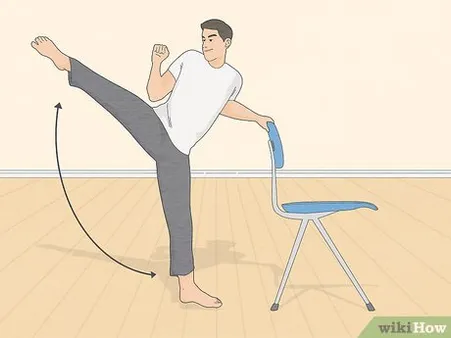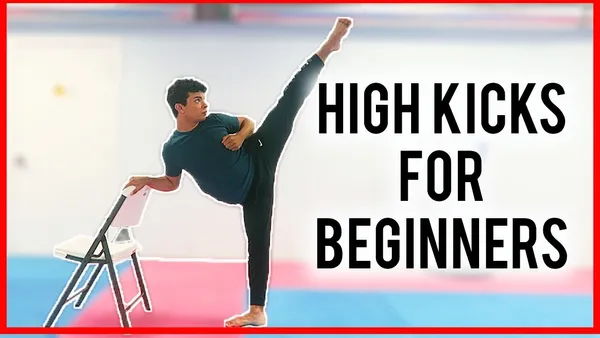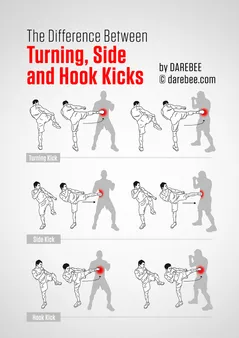Table of Contents
Welcome to Kizworld's definitive guide to kicking. We explore the art of kicking, a skill that combines power, precision, and control. Whether your goal is self-defense, martial arts mastery, or overall fitness, this comprehensive guide provides invaluable insights into How to do a kick effectively. We'll delve into leg anatomy, different types of kicks, training exercises, and common mistakes to avoid. Get ready to elevate your kicking skills and unlock your full potential with Kizworld.
How to do a Kick: Unleash Your Inner Power and Precision
I. Mastering the Art of Kicking: A Comprehensive Guide
Mastering the Art of Kicking: A Comprehensive Guide
Leg Anatomy and Proper Form: The Foundation of Effective Kicking
Kicking is a powerful technique that requires a combination of strength, flexibility, and coordination. Understanding the anatomy of the leg and maintaining proper form are crucial for executing effective kicks. The leg consists of several muscles, including the quadriceps, hamstrings, and calves, which work together to generate power and control. Proper form involves maintaining a stable stance, engaging the core, and extending the kicking leg fully. By mastering the basics of leg anatomy and form, you lay the foundation for powerful and precise kicks.
- Related Post: How to Do a Kick: A Step-by-Step Guide
- Related Post: The Benefits of Gymnastics for Kids: A Path to Physical and Mental Development
Different Types of Kicks and Their Techniques: Exploring the Kicking Arsenal
The world of kicking encompasses a diverse range of techniques, each with its unique characteristics and applications. From the basic front kick to the intricate spinning back kick, each kick serves a specific purpose and requires specialized training. Mastering different types of kicks expands your offensive and defensive capabilities, allowing you to adapt to various situations. Explore the different kicks, understand their mechanics, and practice them diligently to become a well-rounded kicker.
Kick | Description | Applications |
|---|---|---|
Front Kick | A straightforward kick executed by thrusting the front leg forward. | Effective for long-range attacks and keeping opponents at bay. |
Roundhouse Kick | A powerful kick delivered in a circular motion, striking with the ball of the foot. | Useful for attacking the head, body, and legs. |
Side Kick | A kick performed by swinging the leg sideways, striking with the heel or instep. | Effective for attacking the ribs, solar plexus, and head. |
Kicking for Power, Precision, and Control: Exercises and Tips to Enhance Your Kicking Ability
Developing powerful, precise, and controlled kicks requires dedication and consistent practice. Incorporate specific exercises into your training routine to strengthen the muscles involved in kicking, improve flexibility, and enhance coordination. Focus on exercises that target the quadriceps, hamstrings, and calves, such as squats, lunges, and calf raises. Additionally, practice kicking drills to refine your technique and develop muscle memory. With perseverance and focused practice, you can significantly improve the power, precision, and control of your kicks.
- Related Post: The Best Gymnastics Equipment for Home Use: Creating a Personal Training Space
- Related Post: How to Improve Your Flexibility and Mobility with Gymnastics: A Guide to Enhanced Movement
Kicking for Self-Defense: Essential Techniques and Strategies for Personal Protection
Kicking is a valuable self-defense skill that can help you protect yourself in dangerous situations. Learn essential kicking techniques for self-defense, such as the front kick, roundhouse kick, and side kick. Practice these kicks regularly to develop muscle memory and ensure you can execute them effectively under pressure. Additionally, understand the principles of self-defense, such as maintaining awareness, avoiding dangerous situations, and de-escalating conflicts. By combining effective kicking techniques with self-defense strategies, you can significantly enhance your ability to protect yourself and your loved ones.
- Related Post: The History and Evolution of Gymnastics: A Journey Through Time
- Related Post: How to Choose the Right Gymnastics Leotard: A Guide to Comfort, Style, and Performance
Kicking for Sports and Martial Arts: Advanced Techniques for Competition and Performance
If you're involved in sports or martial arts, kicking plays a crucial role in enhancing your performance and achieving success. Master advanced kicking techniques, such as the spinning back kick, hook kick, and axe kick, to expand your offensive arsenal and surprise your opponents. These techniques require a high level of skill, coordination, and flexibility. Practice them diligently and incorporate them into your training routine to become a formidable competitor. Whether you're a seasoned athlete or a martial artist striving for excellence, mastering advanced kicking techniques will elevate your game to new heights.
- Related Post: The Most Common Gymnastics Injuries and How to Prevent Them: A Guide to Safe Training
- Related Post: The Difference Between Artistic, Rhythmic, and Acrobatic Gymnastics: Exploring the Unique Disciplines
Training and Safety: Kicking With Proficient Skills and Minimizing Risks
Kicking effectively and safely requires a comprehensive approach to training and injury prevention. Develop a structured training plan that includes warm-ups, drills, and practice sessions. Gradually increase the intensity and duration of your training to avoid overexertion and potential injuries. Additionally, pay attention to proper form and technique to minimize the risk of muscle strains, sprains, and other injuries. Incorporate stretching and flexibility exercises into your routine to enhance your range of motion and reduce the likelihood of injuries. By following these guidelines, you can train safely and effectively, maximizing your kicking skills while minimizing the risk of harm.
- Related Post: The Best Gymnastics Exercises for Core Strength: Building a Solid Foundation
- Related Post: How to Master the Basic Gymnastics Skills: A Step-by-Step Guide for Beginners
Troubleshooting Common Mistakes in Kicking: Identifying and Correcting Errors for Improved Performance
Kicking is a complex skill that requires practice and attention to detail. Along the way, you may encounter common mistakes that hinder your progress and limit your kicking ability. These mistakes can range from improper form and technique to inadequate flexibility and strength. To improve your kicking skills, it's essential to identify and correct these mistakes. Analyze your kicking technique, seek feedback from experienced coaches or training partners, and incorporate corrective exercises into your routine. By addressing common mistakes and refining your technique, you can significantly enhance your kicking performance and achieve your martial arts or fitness goals.
- Related Post: The Top Gymnastics Competitions and Events: A Showcase of Elite Performance
- Related Post: The Most Famous Gymnasts of All Time: Legends of the Sport
II. Delving into Different Types of Kicks
Delving into Different Types of Kicks
Journey Through Karate's Diverse Kicking Techniques
- Front Kick: A straightforward yet potent kick, striking with the ball of the foot.
- Roundhouse Kick: A spinning kick that generates power from hip rotation and strikes with the heel or shin.
- Side Kick: A sideways thrust kick, delivered with the outer edge of the foot.
Karate boasts an extensive repertoire of kicking techniques, each with distinct characteristics. These kicks vary in form, targeting different areas, and require different levels of flexibility and coordination. We delve into the world of karate kicks, exploring the basics and advanced techniques.
For the uninitiated, the front kick stands as a fundamental technique in karate. It involves extending the leg forward and striking with the ball of the foot. This kick emphasizes balance, focus, and proper extension of the leg. The roundhouse kick, on the other hand, is a dynamic and powerful technique. It is executed by rotating the hip while swinging the leg in a circular motion, culminating in a strike with the heel or shin. This kick requires excellent coordination and flexibility. Lastly, the side kick, known for its sharp and forceful impact, is delivered by thrusting the leg sideways with the outer edge of the foot. Mastering the side kick demands a high level of flexibility and core strength.
Tae Kwon Do: Kicking with Speed, Precision, and Variety
- Ap Chagi: A swift front kick, known for its lightning-fast execution.
- Yop Chagi: A side kick that strikes with the heel, aiming for the opponent's head or body.
- Dolyeo Chagi: A jumping roundhouse kick, showcasing both power and agility.
In the realm of martial arts, Tae Kwon Do distinguishes itself with its emphasis on kicking techniques. Tae Kwon Do practitioners develop lightning-fast kicks, remarkable precision, and a vast arsenal of kicking variations. Among the fundamental kicks is the Ap Chagi, characterized by its swift execution and ability to strike at various levels. The Yop Chagi, another essential technique, targets the opponent's head or body with the heel, requiring precise aim and control. For those seeking spectacular displays of athleticism, the Dolyeo Chagi, a jumping roundhouse kick, combines power, agility, and impressive height.
Tae Kwon Do practitioners extensively train to master these kicking techniques, honing their skills through rigorous practice. These kicks demand focus, coordination, and a high level of flexibility. They not only enhance self-defense capabilities but also contribute to the art's dynamic and captivating nature. For those aspiring to excel in kicking, Tae Kwon Do presents a rich tapestry of techniques to explore and perfect.
Muay Thai: Unleashing Raw Power and Devastating Strikes
- Teep: A powerful front kick that emphasizes distance control and can stop an opponent in their tracks.
- Roundhouse Kick: Similar to its karate counterpart, but often executed with greater force and targeting the opponent's legs.
- Knee Strike: A unique and potent technique, where the knee is driven into the opponent's body or head.
Muay Thai, also known as the "Art of Eight Limbs," is renowned for its devastating striking techniques, including a variety of kicks. The Teep, a fundamental kick in Muay Thai, is a potent front kick that targets the opponent's midsection or face. It is used to control distance, set up combinations, and stop an opponent's advances. The Roundhouse Kick, a powerful spinning kick, is similar to the one found in karate. However, in Muay Thai, it is often executed with greater force and accuracy, often aiming for the opponent's legs or body. A technique unique to Muay Thai is the Knee Strike, where the knee is propelled forward or upward, striking the opponent with devastating force.
Muay Thai practitioners, known as nak muay, undergo rigorous training to develop their kicking skills. They focus on building strength, speed, and precision in their strikes. These kicks are not only used in self-defense but also form the backbone of Muay Thai's dynamic and exciting fighting style. Whether it's the Teep, the Roundhouse Kick, or the Knee Strike, Muay Thai's kicks are a testament to the art's raw power and effectiveness.
III. Unveiling the Science Behind a Powerful Kick
Unveiling the Science Behind a Powerful Kick
Kicking is an art form that requires finesse, strength, and knowledge. It requires a series of precisely coordinated movements and careful alignment of the body. A powerful kick, in particular, involves the coordinated activation of multiple muscle groups that generates force, stabilizes the body, and ensures proper technique.
To understand the science behind a powerful kick, we must examine the leg anatomy and the mechanics of different types of kicks. The neuromuscular system plays a crucial role in the execution of a kick, as nerve impulses trigger muscle contractions and ensure proper coordination.
Muscle Group | Function |
Quadriceps | Extension of the knee joint |
Hamstrings | Flexion of the knee joint |
Calves | Plantar flexion of the ankle joint |
Gluteus Maximus | Extension of the hip joint |
Iliopsoas | Flexion of the hip joint |
Each kick technique involves unique biomechanical principles to generate power and control. Here are some common types of kicks along with their key mechanics:
- Front Kick: Straight and swift kick involving the extension of the knee and hip joints, primarily utilizing the quadriceps and iliopsoas muscles.
- Roundhouse Kick: Circular kick generated by the rotation of the torso and hip, engaging the core muscles along with the quadriceps and hamstrings.
- Side Kick: Horizontal kick executed by extending the leg from a chambered position, primarily relying on the quadriceps and gluteus maximus muscles.
- Hook Kick: Arcing kick involving the bending and snapping of the knee, engaging the hamstrings and calves for maximum power.
- Axe Kick: Downward vertical kick performed by swinging the leg in a chopping motion, utilizing the hamstrings, quadriceps, and core muscles.
To develop powerful kicks, it's essential to focus on strengthening the leg muscles, improving flexibility and balance, and mastering proper technique. Regular practice, drills, and feedback from experienced martial artists or instructors can help refine these skills.
In conclusion, the science behind a powerful kick lies in the intricate interplay of muscle activation, proper technique, and biomechanical principles. By understanding these concepts and practicing diligently, martial artists can develop devastating kicks that are both effective and aesthetically pleasing.
IV. Developing Technique for Effective Kicking
Developing Technique for Effective Kicking
Mastering Proper Kicking Form
To enhance your kicking efficiency, focus on refining your form. Perfecting the mechanics of each kick, including proper stance, leg alignment, and weight distribution, will optimize power, precision, and control.
Kick kizworld's guide the best martial arts for self-defense to strengthen these fundamental skills and master various kicking techniques.
Kick Type | Description and Usage |
Front Kick | Thrusting kick frequently utilized for long-range strikes. It is suitable for both offense and defense. |
Roundhouse Kick | Powerful circular kick commonly used to generate force and target opponents' midsection or head. |
Side Kick | Horizontal kick often employed as a counterattack or to maintain distance against opponents. |
Kicking Drills and Exercises
To refine your kicks, incorporate dedicated drills into your training regimen. Begin with slow, controlled repetitions, gradually ramping up speed and power as you gain proficiency.
Maximize your kicking potential by building strength and flexibility through compatible exercises. Integrate movements like leg raises, squats, and hip flexor stretches to augment your range of motion and kicking capabilities.
Leveraging the Power of Your Kicks
Unlock the full force of your kicks with proper technique. Engage your core, drive power from your hips, and transfer energy through the length of your leg into the strike. Execute each kick swiftly and forcefully to maximize impact.
Refine your kicks by alternating between power and precision. Develop aggressive, high-impact kicks for offensive maneuvers while also honing controlled, targeted kicks for defensive scenarios.
- Maintain balance and coordination during kicks to execute them effectively.
- Kick with pointed toes to enhance impact and reduce the chance of injury.
- Choose appropriate footwear based on your kicking style and training surface.
V. Conclusion
Kicking is a multifaceted technique that requires dedication, practice, and a deep understanding of biomechanics. As you progress in your kicking journey, remember to focus on developing strong leg muscles, maintaining proper form, and practicing regularly to refine your technique. With consistency and commitment, you can harness the power and precision of kicks, enhancing your overall fitness, self-defense capabilities, and martial arts prowess. Whether you're a seasoned martial artist or a beginner seeking to improve your kicking skills, Kizworld's guide provides a comprehensive roadmap to help you achieve your goals.